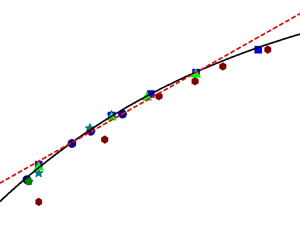Published online by Cambridge University Press: 23 December 2021

The dominant paradigm in turbulent wall flows is that the mean velocity near the wall, when scaled on wall variables, is independent of the friction Reynolds number  $Re_\tau$. This paradigm faces challenges when applied to fluctuations but has received serious attention only recently. Here, by extending our earlier work (Chen & Sreenivasan, J. Fluid Mech., vol. 908, 2021, p. R3) we present a promising perspective, and support it with data, that fluctuations displaying non-zero wall values, or near-wall peaks, are bounded for large values of
$Re_\tau$. This paradigm faces challenges when applied to fluctuations but has received serious attention only recently. Here, by extending our earlier work (Chen & Sreenivasan, J. Fluid Mech., vol. 908, 2021, p. R3) we present a promising perspective, and support it with data, that fluctuations displaying non-zero wall values, or near-wall peaks, are bounded for large values of  $Re_\tau$, owing to the natural constraint that the dissipation rate is bounded. Specifically,
$Re_\tau$, owing to the natural constraint that the dissipation rate is bounded. Specifically,  $\varPhi _\infty - \varPhi = C_\varPhi \,Re_\tau ^{-1/4},$ where
$\varPhi _\infty - \varPhi = C_\varPhi \,Re_\tau ^{-1/4},$ where  $\varPhi$ represents the maximum value of any of the following quantities: energy dissipation rate, turbulent diffusion, fluctuations of pressure, streamwise and spanwise velocities, squares of vorticity components, and the wall values of pressure and shear stresses; the subscript
$\varPhi$ represents the maximum value of any of the following quantities: energy dissipation rate, turbulent diffusion, fluctuations of pressure, streamwise and spanwise velocities, squares of vorticity components, and the wall values of pressure and shear stresses; the subscript  $\infty$ denotes the bounded asymptotic value of
$\infty$ denotes the bounded asymptotic value of  $\varPhi$, and the coefficient
$\varPhi$, and the coefficient  $C_\varPhi$ depends on
$C_\varPhi$ depends on  $\varPhi$ but not on
$\varPhi$ but not on  $Re_\tau$. Moreover, there exists a scaling law for the maximum value in the wall-normal direction of high-order moments, of the form
$Re_\tau$. Moreover, there exists a scaling law for the maximum value in the wall-normal direction of high-order moments, of the form  $\langle \varphi ^{2q}\rangle ^{{1}/{q}}_{max}= \alpha _q-\beta _q\,Re^{-1/4}_\tau$, where
$\langle \varphi ^{2q}\rangle ^{{1}/{q}}_{max}= \alpha _q-\beta _q\,Re^{-1/4}_\tau$, where  $\varphi$ represents the streamwise or spanwise velocity fluctuation, and
$\varphi$ represents the streamwise or spanwise velocity fluctuation, and  $\alpha _q$ and
$\alpha _q$ and  $\beta _q$ are independent of
$\beta _q$ are independent of  $Re_\tau$. Excellent agreement with available data is observed. A stochastic process for which the random variable has the form just mentioned, referred to here as the ‘linear
$Re_\tau$. Excellent agreement with available data is observed. A stochastic process for which the random variable has the form just mentioned, referred to here as the ‘linear  $q$-norm Gaussian’, is proposed to explain the observed linear dependence of
$q$-norm Gaussian’, is proposed to explain the observed linear dependence of  $\alpha _q$ on
$\alpha _q$ on  $q$.
$q$.